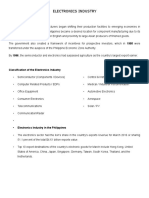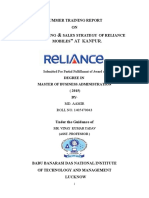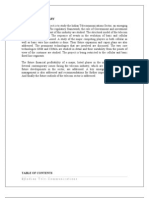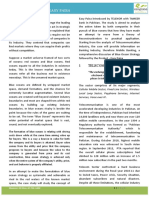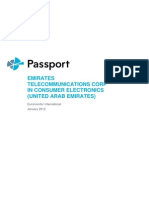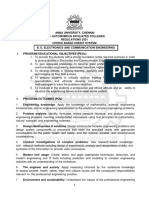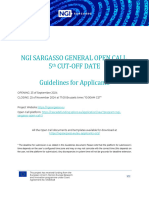AMTA 2004 Annual Report PDF
AMTA 2004 Annual Report PDF
Uploaded by
extra_ordinarymanCopyright:
Available Formats
AMTA 2004 Annual Report PDF
AMTA 2004 Annual Report PDF
Uploaded by
extra_ordinarymanCopyright
Available Formats
Share this document
Did you find this document useful?
Is this content inappropriate?
Copyright:
Available Formats
AMTA 2004 Annual Report PDF
AMTA 2004 Annual Report PDF
Uploaded by
extra_ordinarymanCopyright:
Available Formats
AMTA 2004 Annual Report
2004 Annual Report
AMTA - Australian Mobile Telecommunications Association
Australian Mobile Telecommunications Association Limited 1
AMTA 2004 Annual Report
PO Box 4309 Manuka ACT 2603 Australia
Phone: (02) 6239 6555
Fax: (02) 6239 6577
www.amta.org.au
ABN 98 065 814 315
Design and Layout by:
2 Australian Mobile Telecommunications Association Limited
AMTA 2004 Annual Report
Contents
1 AMTA - Statement of Purpose and Vision 4
2 Overview of the Australian Mobile Telecommunications Industry 5
3 President’s Report 7
4 Chief Executive Officer’s Report 9
5 Highlights 11
Industry Member Focused 11
Consumer Driven 11
Economically Successful 11
Socially Responsible 12
Environmentally Responsible 13
6 Mobile Carriers Forum 14
7 Policy and Strategy Steering Committee 16
8 Health and Safety Committee 18
9 Consumer Committee 19
10 Mobile Phone Recycling Committee 21
11 Lost and Stolen Committee 22
12 Accessibility Committee 23
13 AMTA Board 24
14 AMTA Staff 25
15 AMTA Members 26
Australian Mobile Telecommunications Association Limited 3
AMTA 2004 Annual Report
1 AMTA – Statement of Purpose and Vision
The Australian Mobile Telecommunications Association (AMTA) is the peak national body representing
Australia’s mobile telecommunications industry.
AMTA’s vision is to promote an environmentally, socially and economically responsible and successful mobile
telecommunications industry in Australia.
AMTA aims to achieve its vision by:
Effective industry representation and leadership.
Generating consensus on whole-of-industry issues.
Improving the level of trust between the industry, its key stakeholders and the wider community.
Promoting an improved understanding of the mobile telephone industry and its contribution to the
Australian community.
AMTA promotes mobile telecommunications applications in Australia for the benefit of all industry participants
and users. Mobile telecommunications in Australia is a major industry. It contributes nearly $5 billion a year to
the Australian economy and employs more than 34,500 people.
From small beginnings, the mobile telecommunications industry today has about 16 million subscribers with
an estimated mobile penetration rate of 80%.
AMTA represents, acts and communicates on behalf of industry to key stakeholders and decision makers:
governments; regulatory authorities; consumer groups; and mobile users.
AMTA’s members include:
Mobile phone carriers and service providers.
Handset manufacturers.
Retail outlets.
Network equipment suppliers and associated businesses.
Specialised consultancy services.
AMTA’s focus is wider than the economic bottom line. Mobile phones have had a marked impact on people’s
lives and AMTA is committed to providing practical assistance to users through such programs as recycling,
lost and stolen mobiles and consumer tips.
4 Australian Mobile Telecommunications Association Limited
AMTA 2004 Annual Report
2 Overview of the Australian Mobile
Telecommunications Industry
The Australian mobile telecommunications industry has been a strong performer over the past 10 years and
recent innovations provide a platform for continued strong performance.
The following indicators demonstrate the economic significance of the mobile telecommunications industry in
Australia:
Industry Gross Product for the Carriage Service Providers (CSP) sector in 2002-03 was $4.8 billion.
– Industry Gross Product (IGP) is a measure of the economic contribution of a specific industry to
the economy or value added.
– The contribution of the mobile telecommunications sector to the economy was larger than the
free-to-air television services industry and also larger than the newspaper, printing and publishing
industry. The contribution of the mobile telecommunications sector was almost one third of the entire
accommodation, cafes and restaurants industry.
The industry contributes substantially to government revenues through charges and levies and
through the full range of Commonwealth and State generic industry taxes and charges.
– It is estimated that on-going industry specific payments made by the mobile telecommunications
industry to government are in the order of two per cent of revenue per year or $178.2 million
in 2003-04.
– The industry has contributed almost $2.9 billion to government through payments made to
access spectrum.
– The industry contributes to effective industry operation through payments, some voluntary
and some compulsory, that support various industry associations and schemes, for example the
Telecommunications Industry Ombudsman and the National Relay Service.
Employment in the mobile telecommunications industry is growing.
– Over 34 500 people worked in the industry (on a full-time, part-time or casual basis) in 2002-
03. Over the period 1997-98 to 2002-03, employment in the mobile telecommunications industry
increased by 48 per cent, compared to an increase of around 30 per cent in the telecommunications
industry as a whole.
– In 2002-03, the mobile telecommunications industry paid around $1.2 billion in wages.
– Mobile telecommunications accounted for over one third of total telecommunications employment
in 2002-03. By comparison, in 1996-97, mobile telecommunication employees accounted for just
under one quarter of total telecommunications employment.
Australian Mobile Telecommunications Association Limited 5
AMTA 2004 Annual Report
Capital expenditure by the industry has been substantial.
– In 2003-04, the industry continued its capital expenditures to support new networks and
expansions and upgrades to existing networks. This is in addition to regular operating expenditures.
– Since 1997, capital expenditure on new networks has exceeded $8 billion. These investments
underpin expansions to mobile network coverage that make mobile services available to more
people in more places as well as supporting the development of innovative services.
Revenue in the mobile telecommunications industry exceeds $8 billion annually.
– An estimate of mobile telecommunications industry revenue for 2003-04 was $8.8 billion.
– In 2002-03, mobile revenue represented 28 per cent of total telecommunications revenue.
Lynda O’Grady, AMTA President, Daryl Williams,
the former Minister for Communications, Information
Technology and the Arts, and Keir Preedy, AMTA Vice-
President, at the Dinner for the Minister.
Brent Gerstle, Optus, Michael Milligan, Mobile
Manufacturers Forum, Bernie O’Shannassy, Motorola,
at the Dinner for the Minister in Sydney last December
6 Australian Mobile Telecommunications Association Limited
AMTA 2004 Annual Report
3 President’s Report
Our industry is positioned for a renewed period of strong growth to capture the latest developments in mobile
telephone technology.
The industry has constructed a strong platform for growth with the introduction of 3G mobile technology.
The growing impact and importance of our industry to the Australian economy has been measured in the
latest industry report, which finds that Australia’s mobile telecommunications industry contributes $4.8 billion
a year to the local economy.
The latest snapshot of the industry, undertaken by the Allen Consulting Group on behalf of the Australian
Mobile Telecommunications Association (AMTA), finds a strong, vibrant industry employing more than 34,500
people with revenue of $8.8 billion in 2003-04.
Our industry has a bigger economic impact on Australia than either the free-to-air television services industry
or the newspapers, printing and publishing industry.
Peaks in subscriber growth have in the past been associated with the introduction of new networks, such as
in 1993 when the 2G GSM network was introduced and in 1999 with the CDMA networks.
After a period of consolidation, the industry is poised for a new phase in growth over the coming years when
the full impact of 3G services on mobile growth rates comes into effect.
AMTA has equipped itself to ensure that it continues its pivotal role in providing leadership and
representation for its members on whole-of-industry issues. AMTA is reinvigorating itself to meet new
challenges with a new Constitution to ensure it continues to deliver results for its members.
AMTA’s renewed task and focus has been outlined for the next three years in the 2004-07 Strategic Plan,
which provides a series of steps to build a stronger and more effective organisation for its members.
AMTA has demonstrated it is an innovative and forward-thinking organisation with its new social research
project, which was launched at AMTA’s Annual Congress in September.
To further understand the nature and extent of the impact of mobiles on our lives, AMTA collaborated with
the Academy of the Social Sciences in Australia to produce a framework for an ongoing research program
of three years or more. Nowhere in the world has such research been undertaken at peak industry level.
To fulfill its vision to promote an environmentally, socially and economically responsible and successful
mobile telecommunications industry in Australia, AMTA undertakes a number of key programs:
AMTA oversees the industry’s mobile recycling program, which has, since it started in 1999,
collected and recycled more than 250 tonnes of mobile handsets, batteries and accessories.
The program, which is free to consumers and funded by a levy on the sale of new mobile phone
handsets from participating manufacturers and network carriers, is entering a new phase with the
incorporation of major corporations and government departments into the program.
Australian Mobile Telecommunications Association Limited 7
AMTA 2004 Annual Report
They include: the Department of Communications, Information Technology and the Arts; the
Australian Taxation Office; Toyota; and BHP Billiton Petroleum.
The Australian mobile telephone industry introduced a world first, anti-theft technology which blocks
lost or stolen mobile phones by using each phone’s unique 15-digit electronic serial number. More
than 200,000 mobiles have been blocked since the program started 12 months ago and AMTA
recently introduced a new online inquiry service that makes it convenient for consumers and second-
hand sellers to check if a mobile telephone has been reported lost or stolen and blocked from use by
the network carriers.
In the past year AMTA has worked to better educate and increase the awareness of consumers on
a range of issues. This has included producing consumer tips on managing spending on mobiles
and the appropriate use of camera phones. AMTA places great emphasis on the importance of
assisting consumers to have access to the benefits of mobile phones in a financially affordable and
responsible manner.
AMTA made a submission to the Federal Government’s Financial Literacy Taskforce, which
considered ways to improve the financial skills of Australian consumers. AMTA supports the
Taskforce’s recommendations for a co-ordinated, nation-wide approach to improve the financial
awareness of consumers, starting from school age. AMTA is considering working with education
authorities to include a mobile phone module as part of an accredited consumer and financial skills
course in schools.
I would like to thank my fellow Board members for their support, guidance and commitment over the past 12
months. We have positioned AMTA to ensure it remains relevant to the evolving needs of its members and it
is well structured and resourced to face new challenges and opportunities of an innovative industry entering
a new phase in its development that goes far beyond the traditional functions of making and receiving calls
and text messages.
I also take this opportunity to thank AMTA’s Chief Executive, Graham Chalker, and his dedicated staff for
their commitment and diligence in delivering results for our members.
Our industry has much to be proud of. AMTA continues to serve the industry well. We will not rest on our
laurels and we remain committed to promoting an environmentally, socially and economically responsible
and successful telecommunications industry.
AMTA President, Lynda O’Grady, Telstra Corporation,
at the Dinner for the Minister in Sydney last December
8 Australian Mobile Telecommunications Association Limited
AMTA 2004 Annual Report
4 Chief Executive Officer’s Report
This year has been a particularly busy year for AMTA. We have faced and addressed a wide range of issues
while the industry has continued to grow and contribute significantly to the Australian economy.
A key strength of our organisation is the ability to develop and present policies to improve the business
environment of our members. AMTA also works closely with consumer and community groups to ensure it
meets is corporate social responsibilities and serves the needs of customers.
At the very heart of AMTA’s work is our committee system, which generates policies and positions on a range
of whole-of-industry issues.
AMTA’s committees are our organisation’s engine room. They provide members with a mechanism to ensure
the industry contributes to and shapes public policy debate by presenting a unified industry voice.
I take this opportunity to thank all committee chairs and members for their dedication, enthusiasm, insight
and input in developing policies and positions which have stood our organisation and industry in good stead
over the past year.
The committee structure reflects the gamut of our industry’s issues, ranging across economic, social and
environmental issues. The committees include: infrastructure; consumer issues; recycling; health and safety;
lost and stolen; policy and strategy; and access for the disabled. The work of these committees will be
detailed later in this report.
One area where the industry has faced criticism has been the issue of debt and high bills. AMTA made a
submission on behalf of its members to the Australian Communication Authority’s inquiry into unexpected
high bills and credit management.
Our response provided a good example of the interdependency of financial matters with consumer-related
issues, such as education and awareness. It underscores the importance of tackling issues not just in
financial terms, but also looking at attitudes and the importance of providing practical information to help
consumers make informed decisions.
We believe that credit management problems appear limited in size and scope. The competitive market has
provided a solution with the growth of pre-paid phones which have been taken up with alacrity by customers.
Imposing caps and using black letter law runs the risk of inconveniencing the majority of consumers and not
necessarily helping the small number who are affected.
Our industry is already party to comprehensive co-regulatory codes of practice. Individual companies provide
spending alerts to monitor unusual expenditure by customers.
AMTA’s submission was cast in the wider social context of detailing the work we do to enhance awareness
and sensible attitudes to money management that can help all consumers. Our submission details our steps
to improve financial knowledge with our Consumer Tips; our work with the Financial Literacy Taskforce; our
industry initiative to protect people from high bills by blocking their mobile phone if it is reported lost
or stolen.
Australian Mobile Telecommunications Association Limited 9
AMTA 2004 Annual Report
AMTA strongly believes our approach is balanced and effective.
Later this year, I am meeting with State Transport and Police Ministers and motoring organisations to discuss
the issue of driving and mobile telephones.
AMTA has produced driving safety tips; drivers who adhere to these simple common sense practices
can make full, productive and safe use of mobile phones while enjoying the substantial public safety and
personal security benefits they provide. We are concerned that the debate in Australia has focused on
mobiles at the expense of other distractions.
AMTA’s Mobile Carriers Forum (MCF) has this year fulfilled its important charter to respond to community
issues about the deployment of vital infrastructure for our industry.
With the introduction of 3G technology our industry faces new challenges in responding to some community
concerns surrounding the siting of mobile phone base stations while ensuring that the community has
adequate coverage to access vital new services.
One of the highlights of AMTA’s year and the culmination of hard work and planning is our Annual Congress,
which provides a forum for the industry to come together and to hear first hand of the latest issues and
trends and to network with colleagues in the industry.
The Congress, held in Sydney, was very well attended. One of the highlights was the Roundtable with
the four CEOs of the carriers. Our industry’s leaders participated in a question and answer session which
provided great insight on key issues.
Finally, I would like to thank AMTA’s President, Lynda O’Grady, and the Board for their support and guidance
during the year. I extend my gratitude to AMTA’s staff for their diligence, dedication and professionalism.
AMTA CEO, Graham Chalker, at the Dinner for the
Minister in Sydney last December
10 Australian Mobile Telecommunications Association Limited
AMTA 2004 Annual Report
5 Highlights
Industry Member Focused:
AMTA Member Forums – AMTA provides members with networking opportunities. This year’s
Forums were addressed by: Lisa Tuffs, Business Development Manager, Ericsson Australia Pty
Ltd; John Grant, Senior Executive Manager, Radiocommunications, Australian Communications
Authority; Dr Richard Allen, Managing Director, Applied Financial Diagnostics Pty Ltd; Dr Graeme
Woodbridge, Senior Telecommunications Analyst, CommSeC.
Member Communications – The daily summary of Health and Safety issues goes to 50 members
and receives positive feedback. AMTA’s monthly enewsletter is circulated to 470 members and
brings significant traffic to the AMTA website. The quarterly EME Update is circulated to more than
400 people from member companies, government agencies and the media.
Dinner with the Minister – The then new Minister for Communications, Information Technology and
the Arts, Daryl Williams QC, joined the AMTA Board and Members at a dinner in Sydney
on December 17.
PM’s XI – The AMTA marquee at the Prime Minister’s XI cricket match in Canberra on January 28,
2004, provided a great opportunity for AMTA members to meet with senior officials and ministerial
staffers in an informal setting.
AMTA Congress – About 150 people attended this year’s AMTA Congress in Sydney on September
21-22. The two-day conference provided a timely opportunity for our industry to come together
and get an update on legislative, regulatory and policy developments; to hear from CEOs of
the carriers and manufacturers; to hear of the global economic outlook and trends in the mobile
telephone industry.
Consumer Driven:
Economically Successful:
Industry Report – Australia’s mobile telecommunications industry contributes $4.8 billion a year
to the local economy and is positioned for strong growth opportunities with the roll out of third-
generation technology. The report, undertaken by the Allen Consulting Group, found that the
economic contribution of the mobile telephone industry in Australia is greater than either the free-to-
air television services industry or the newspapers, printing and publishing industry.
Credit Management Inquiry - AMTA made a submission to the Australian Communication
Authority’s inquiry into unexpected high bills and credit management. Our analysis shows that credit
management problems appear limited in size and scope. The competitive market has provided a
solution with the growth of pre-paid phones, which have been taken up with alacrity by customers.
AMTA said imposing caps and using black letter law runs the risk of inconveniencing the majority of
consumers and not necessarily helping the small number who are affected.
Australian Mobile Telecommunications Association Limited 11
AMTA 2004 Annual Report
Industry Statistics – AMTA released statistics on monthly sales of mobile handsets throughout the
year. According to the latest figures for September, 2004, there were 5.87 million sales in the nine
months of this year. This is a 45 per cent increase over the same period last year. Growth in
pre-paid mobiles and people upgrading to the latest technology are two of the major drivers of the
big rise in sales.
The four Carrier CEOs at the AMTA Congress.
Grahame Maher, Vodafone, Allen Lew, Optus, David
Moffatt, Telstra, Kevin Russell, Hutchison
Socially Responsible:
Driving and Mobiles – AMTA has embarked on a series of meetings with State Transport Ministers
and chiefs of motoring organisations to advise them of the steps the mobile telecommunications
industry is taking to alert drivers to the acceptable use of mobile phones while driving.
Social Research – Australia’s leading social scientists have joined with the mobile
telecommunications industry in a world first to develop a research agenda to gain a wider
understanding of the social impact of mobile telephones. The Academy of the Social Sciences in
Australia joined with AMTA at the Annual Congress to launch a discussion paper setting an agenda
for future research into the impact of the mobile phone on our society.
Lost and Stolen – AMTA launched a new online inquiry service that makes it convenient for
consumers and second-hand sellers to check if a mobile telephone has been reported lost or stolen
and blocked from use by the network carriers. AMTA also welcomed new Federal Government
legislation that makes it a criminal offence to “rebirth” stolen phones by illegally modifying a phone’s
electronic serial number.
Tips on Buying Your Mobile, Managing Your Mobile Spend – Fulfilling its charter to promote a
socially-responsible industry, AMTA has produced a number of Consumer Tips to offer step-by-step,
practical help to consumers. These tips have been widely distributed to Federal authorities, State
Fair Trading bodies, education authorities, consumer organisations and the media.
Disabilities – Following the HREOC Forum held late in 2003, AMTA established its Accessibility
(Disability) Committee. The Committee has developed an action plan to ensure that disability
issues are considered as part of AMTA’s consideration of all issues and to improve access to
mobile services for people with disabilities. AMTA’s website has been made accessible to people
with a disability.
12 Australian Mobile Telecommunications Association Limited
AMTA 2004 Annual Report
Financial Literacy Taskforce – AMTA provided a submission to the Federal Government’s
Consumer and Financial Literacy Taskforce. We supported the objectives of the Taskforce to improve
the financial skills of young Australians. AMTA proposes to work with education authorities to
produce mobile phone material for use in the school curricula.
Environmentally Responsible:
Mobile Phone Recycling – The mobile telephone industry continues to lead with its strong
commitment to product stewardship. The recycling program collected 61 tonnes of handsets,
batteries and accessories in 2003-04. This brings the total collection to 255 tonnes since the
program started in 1999.
International Recycling Conference - Environment Canada invited AMTA to present a paper at the
Third National Workshop on Extended Producer Responsibilty in Nova Scotia, Canada, in March.
Following the presentation, AMTA was congratulated on its recycling program.
New Phase – The Recycling Program is entering a new phase with the signing of major corporations
and government departments. This year the Australian Taxation Office and the Department of
Communications, Information Technology and the Arts joined the recycling program along with
Toyota and BHP Billiton Petroleum.
The Minister for Communications, Information
Technology and the Arts, Senator Helen Coonan,
gives the keynote address at AMTA’s Congress in
Sydney in September.
AMTA Board Member, Alan Nicklos (Motorola)
Australian Mobile Telecommunications Association Limited 13
AMTA 2004 Annual Report
6 Mobile Carriers Forum
Chair: Ros Young, Vodafone
Tanya Stoianoff
Executive Director
The Mobile Carriers Forum (MCF), comprising the four mobile phone carriers in Australia - Hutchison, Optus,
Telstra and Vodafone - is responsible for addressing social and environmental issues within the policy,
regulatory and operational environment associated with the deployment and operation of mobile phone
networks. The MCF strives to ensure that the mobile carriers’ industry as a whole addresses community and
Government expectations in this area.
Internationally, the MCF is recognised as having developed and implemented world-leading policies and
management tools for carriers in addressing social, environmental and carrier co-ordination issues in
deployment. The co-operation between carriers in Australia in addressing these issues is second to none.
Further, the MCF Executive Director presented a paper, “World Leading Practices of the MCF”, at the Third
EMF Biological Effects Conference in Greece.
The MCF’s comprehensive work agenda has necessitated regular roundtable discussion on how industry
delivers the deployment and operation of mobile phone networks, as well as enhances consultation with
governments and the community. This past year, MCF committees, of which there are twelve, focused on
key issues of concern to carriers and our community. Whether they are the regional forums addressing
co-ordinated local network rollout in each state or national taskforces addressing key areas such as visual
amenity, EME and regulatory codes, all have played an important role in developing policy and co-ordinated
processes for the Australian industry.
MCF activities during 2003-04 included:
Releasing the second edition of the MCF Guidelines for Better Visual Outcomes in an effort to set
the benchmark for base station design while recognising the changing regulatory environment in
which carriers deploy their networks.
Responding to community concerns about base station deployment and related EME issues with
ARPANSA through the provision of information, media statements, co-ordinated meetings and
workshops for key stakeholders, such as local councils and Federal and State politicians.
Completing the EME Rooftop Management Trial to test a co-ordinated process for the collation
and communication of carrier facility information on non-carrier owned property. This Trial formed
the basis of the MCF’s EME regulatory compliance strategy which was collectively
developed by the carriers. This resulted in a web-based system being used by all carriers and other
radio licensees;
14 Australian Mobile Telecommunications Association Limited
AMTA 2004 Annual Report
Hosting a web-based management system to help Carriers implement the requirements of the new
ACIF Code, entitled: “Industry Code for the Deployment of Radiocommunications Infrastructure”
(the Code).
Developing awareness at a State Government level of the importance of mobile phone infrastructure
to business and communities in a carrier co-ordinated way.
Working with State Government agencies to streamline processes for utilising existing state-owned
infrastructure corridors for expanding carrier networks.
Representing the carriers’ views and policies in public forums and regulatory forums such as the
review of the above mentioned Code.
Delivering a comprehensive local and national media campaign promoting information on base
station deployment, the regulatory environment in which carriers deploy, and the international
position of authorities such as the World Health Organisation on EME and health.
Providing a point of contact for community groups, councils, government, the media and other
stakeholders in addressing issues related to infrastructure deployment in Australia.
In the pursuit of enhanced community consultation and industry co-ordination, the MCF has earned national
political recognition and has demonstrated a vital ability to develop strong and supportive relationships with
Federal and State Governments and politicians.
Local Councils have also welcomed the co-ordinated and co-operative approach from Carriers through one
voice. However, the need for the MCF to continue to co-ordinate Carriers in working together to address
community and environmental issues remains a key requirement and expectation from both government and
the broader community.
Finally, MCF Chair Ros Young and her National Council have shown great leadership thoughout 2004.
Their tireless dedication to the Forum and its committees is testimony to the MCF’s success.
Front row: Brian Currie, Hutchison Telecoms,
Michael Raj, NSW Department of State and Regional
Development, Ros Young, Vodafone and Chair of the
MCF National Council, Tanya Stoianoff, Executive
Director, MCF. Back row: Andrew Harper, Abbott
Consulting Group, Howard Game, Optus, Peter
Zadien, NSW Department of Infrastructure, Planning
and Natural Resources
Australian Mobile Telecommunications Association Limited 15
AMTA 2004 Annual Report
7 Policy and Strategy Steering Committee
Chair: Georgia-Kate Schubert, Vodafone
David Higginbottom, Telstra (until July 2004)
AMTA’s Policy and Strategy Steering Committee (PSSC) develops strategies which enable the industry to
proactively manage issues in the policy, regulatory and community environment, and it acts as a clearing
house for topical issues.
In the past year, PSSC has undertaken policy responses to a number of key issues, including:
Content.
M-Commerce.
Credit Management.
Emergency services, including the implications of GPS capability.
Roaming.
Taxation, reforming telecommunication specific taxes and charges.
Content:
A sub-committee of the PSSC was formed in late 2003 to examine issues relating to mobile content.
The sub-committee has been extremely active, working with the Australian Communications Authority (ACA),
the Australian Broadcast Authority (ABA), the Department of Communications, Information Technology and
the Arts (DCITA), the Telephone Information Services Standards Council (TISSC), and the Internet Industry
Association on issues relating to the regulation of consumer access to content services on mobile phones,
including restricted and other premium rate and convergent services (eg operator branded portal services).
Credit Management:
A sub-committee was formed to respond to an ACA initiative on credit management issues. Two submissions
were made: one in response to the proposed ACA Service Provider Determinations requiring information
about premium services on the 19x number range and within proprietary networks to be made available to
customers; and a second in response to the ACA’s broader investigation of credit management measures in
place within the industry.
AMTA’s submission to the ACA’s discussion paper argued that the existing regulation and self-regulation
regime offers considerable consumer protection and that the competitive market is producing new products
and services designed to assist various consumer segments manage their expenditure. ACA proposals for
detailed additional regulation are not warranted and would not be effective. The submission is available at:
www.amta.org.au – Reports.
16 Australian Mobile Telecommunications Association Limited
AMTA 2004 Annual Report
Statistics and Information:
The PSSC has been investigating the need for more up-to-date and relevant statistics on the mobile
telecommunications industry. AMTA responded to an Australian Bureau of Statistics review of the
Information, Media and Telecommunications sectors.
AMTA argued the need for specific information on the mobile telecommunications industry given the growth
and increasing importance of mobile telecommunications to the Australian economy. AMTA also argued that
the significant data given by the industry to the Australian Communications Authority could be used by the
ABS to ensure that data requirements on the industry are minimised.
AMTA has been invited to participate in an ABS reference group to determine the content of upcoming
relevant ABS surveys.
M-Commerce:
The PSSC provided a submission to the Standing Committee on Consumer Affairs (comprising
Commonwealth and State officials) on “Considering the implications of M-Commerce – A consumer
perspective”. In its paper, AMTA argues that M-Commerce is a sub-set of E-Commerce and, accordingly,
should be considered within the existing regulatory framework for such transactions.
AMTA Contact: Peppi Wilson, Manager Policy
John Grant, ACA, Georgia-Kate Schubert, Vodafone,
John Kranenburg, SPAN, Brian Currie, Hutchison
Telecoms, at the Dinner for the Minister in Sydney
last December.
Dr John Beaton, the Executive Director of the
Academy of the Social Sciences in Australia, holds the
discussion paper setting an agenda for future research
into the impact of the mobile phone on our society at
AMTA’s Congress in Sydney in September.
Australian Mobile Telecommunications Association Limited 17
AMTA 2004 Annual Report
8 Health and Safety Committee
Chair: Brent Gerstle, Optus
AMTA’s Health and Safety Committee responds to issues regarding the health and safety of mobile
telecommunications.
EME:
ATMA has continued to provide an industry response to the many research findings published during the
year. Particularly notable during the year have been the findings of United Kingdom, Swedish, Netherlands
and Nordic independent experts whose studies found that exposure to radiofrequency fields from mobile
phones and their base stations do not cause any adverse health consequences.
Mobiles and Safe Driving:
One of the major issues in the media during the year has been the use of handheld mobile phones while
driving. AMTA has undertaken a series of meetings with State Transport Ministers and heads of motoring
organisations to advise them of the steps the industry is taking to alert drivers to the appropriate and safe
use of mobiles while driving. We have actively promoted our 10 driving tips through the media, industry
specific publications and occupational, health and safety outlets.
Member Communications:
Daily EME Reports are distributed to keep AMTA members up-to-date on health and safety issues making
headlines in the media. The service allows members to be kept informed of the latest media developments,
allowing them to be prepared to manage key issues affecting them. The EME Quarterly Updates, which
summarise the latest research findings, have been distributed this year to more than 400 members, MPs,
government officials and the media.
Social Research Project:
AMTA has worked with the Academy of the Social Sciences in Australia to produce a discussion paper
setting an agenda and framework for future research into the impact of the mobile phone on our society.
Nowhere in the world has such research been undertaken at peak industry level.
AMTA’s President, Lynda O’Grady, launched the discussion paper at AMTA’s Annual Congress on September
22. She said AMTA was excited and proud to have partnered the Academy on this project, which has brought
together independent, eminent academics in a wide range of disciplines. The project is expected to lead to
new and powerful insights into the impact of mobile phone technology on the way we live, the way we work
and the way we play.
AMTA Contact: Graham Chalker, Chief Executive Officer
18 Australian Mobile Telecommunications Association Limited
AMTA 2004 Annual Report
9 Consumer Committee
Chair: Michelle Curtis, Optus
The Consumer Committee responds positively and proactively to consumers’ concerns regarding mobile
phones.
Financial Literacy Taskforce:
AMTA made a major submission to the Federal Government’s Consumer and Financial Literacy Taskforce,
chaired by Paul Clitheroe. AMTA supported the need for a co-ordinated, national approach to improved
financial awareness for consumers, starting from school age. AMTA said it would work with a national body
proposed by the Taskforce and with education authorities to produce mobile phone material for use in school
curricula, as well as advice to the wider public.
Consumer Information Guides:
As part of a consumer education campaign to address consumer debt issues, the Consumer Committee
prepared two documents to help consumers choose a mobile phone that best suits their needs and to help
them gain access to the benefits offered by mobiles in a financially affordable way.
The two documents: “Tips on Buying Your Mobile” and “Tips on Managing Your Mobile Spend”, provide a
step-by-step guide to choosing a mobile phone plan to suit the particular needs of the consumer and advice
for people to manage their expenditure on mobile services to avoid getting into financial difficulty.
These documents have generated considerable interest in the community. They were distributed widely to
stakeholders and have been the subject of media articles throughout the year.
The Consumer Committee is working with the New South Wales Commission for Children and Young People
on new versions of the Tips to be targeted at young people.
Michelle Curtis, Optus, Matt Stafford, Minister’s Office,
Luisa Ford, Optus, at the Dinner for the Minister in
Sydney last December.
Australian Mobile Telecommunications Association Limited 19
AMTA 2004 Annual Report
Mind Your Mobile Manners:
AMTA’s guide on the dos and don’ts to conform with acceptable use of mobiles in social situations
was distributed widely to industry associations, government departments, local governments and
entertainment bodies.
Guidelines for Use of Camera Phones:
A separate consumer tips sheet was released for the use of camera phones to help ensure privacy is
respected and people use them in a responsible way. The tips emphasise that camera phones can be a
fun way to capture, save and send pictures so users can share important moments with friends and family.
However, people need to be aware of situations that might not be appropriate to take photographs. The
guidelines request camera phone users respect the privacy of others and ask permission before taking an
individual’s picture.
Bullying:
Unfortunately, some bullies use mobile phones to send insulting, threatening or unpleasant voice, text
and picture messages. AMTA is working on a new guide to help victims of bullying. This follows AMTA’s
Developing an Acceptable Use Policy for Mobile Phones in Your School template document, which has been
widely distributed to schools and education authorities throughout Australia, and for which AMTA continues to
receive requests.
All AMTA’s “Consumer Tips” are available on its website – see: www.amta.org.au – consumer tips.
AMTA Contact: Peppi Wilson, Manager Policy
AMTA Board Member, Alexander Lambeek (Nokia Mobile Phones Australia).
20 Australian Mobile Telecommunications Association Limited
AMTA 2004 Annual Report
10 Mobile Phone Recycling Committee
Chair: Ramana James, Vodafone
Product stewardship is in its infancy in Australia. However, the mobile telephone industry has taken the lead
and our industry’s strong commitment to product stewardship is underscored by the Mobile Phone Industry
Recycling Program.
This program has established itself as a world leading environmental “take-back” program, which provides an
effective recycling option for mobile hardware, preventing disposal in landfills.
AMTA’s Recycling Program collected 61 tonnes of handsets, batteries and accessories in 2003-04. This
brings the total collection to 255 tonnes since the program started in 1999. This equates to more than 1.5
million batteries and handsets being recycled and not dumped in landfills.
During the year the Recycling Committee undertook an intensive review of the program and refined the
strategy for the next three years to ensure the program is efficient and effective. The three-year operational
plan will be the blueprint for an expanded program.
Greater emphasis will be placed on expanding the collection channels to ensure we achieve a national
collection network capable of delivering a program that is consistent with a sustainable industry that takes
responsibility for its outputs by capturing a significant amount of mobile phone and accessory waste.
The Committee has decided to undertake a major consumer research survey to better understand consumer
awareness levels and key consumer issues. This will be used to inform and develop a marketing campaign
with the aim of increasing collections.
AMTA will continue to encourage improved environmental outcomes by contributing to the development of
effective product stewardship policy and programs, participating in industry education programs and forums,
and supporting environmental initiatives from government and other stakeholders.
AMTA Contact: Glenn Brown, Manager Business Development
Ramana James, Vodafone, Glenn Brown, AMTA,
Paul Johnston, Vodafone, at the PM’s XI Cricket Match
in Canberra.
Australian Mobile Telecommunications Association Limited 21
AMTA 2004 Annual Report
11 Lost and Stolen Committee
AMTA’s Lost and Stolen Committee identifies and develops short, medium and long-term strategies to assist
in the prevention of mobile phone theft. In addition, the work group utilises statistical information to monitor
and report on the success of the program.
Inter-Carrier Blocking:
September 15 marked the first anniversary of inter-carrier IMEI blocking. Over the 12 months to September
2004, 215,000 mobiles have been blocked, with 46,000 subsequently being unblocked. This represents a
21.3% recovery rate.
The Victoria Police in August issued a media release giving that State’s latest crime statistics for the theft of
mobile phones. In 2002-03, the theft of mobiles decreased from 7861 to 6962. The Victoria Police said that
since the inter-carrier IMEI blocking, the theft of mobile phones had been reduced.
New Online Phone Check:
AMTA launched a new online inquiry service that makes it convenient for consumers and second-hand
sellers to check if a mobile telephone has been reported lost and stolen and blocked from use by the network
carriers. This provides consumers with a quick and easy way to check on the status of a mobile phone.
People can have confidence that a mobile phone they are buying has not been reported lost or stolen.
Rebirthing:
The Senate passed the Crimes Legislation Amendment (Telecommunications Offences and other Measures)
Bill (No.2) 2004 at the end of August. This new law provides for jail terms of up to two years for the rebirthing
of stolen mobile phones. This will assist Law Enforcement Agencies and the industry to tackle the offenders
and further strengthen the mobile theft prevention initiative.
AMTA Contact: Glenn Brown, Manager Business Development
Steve Broderick, Broadcast Australia, David Havyatt,
AAPT Ltd, Adrian Crouch, Ericsson, Takeo Kobayashi,
Sony Ericsson, at the Dinner to Meet the Minister in
Sydney last December.
22 Australian Mobile Telecommunications Association Limited
AMTA 2004 Annual Report
12 Accessibility Committee
Chair: Bert Ciavarra, Telstra
Margaret Portelli, Telstra (until July 2004)
AMTA’s Accessibility Committee enhances disability awareness among AMTA members and develops and
disseminates consumer information for people with a disability.
In late 2003 AMTA established its Disability (later renamed Accessibility) Committee. The Committee has
prepared an AMTA disability action plan as a framework for AMTA’s work with members and disability
organisations. Objectives are to:
Increase members’ awareness of disability issues including overseas developments.
Ensure that disability issues are considered as part of AMTA’s consideration of all issues.
Improve access to mobile services by persons with disabilities.
In particular, AMTA is working with disability organisations to develop:
A whole-of-industry good practices guide for its members seeking continuous improvements for
customers with disabilities accessing mobile equipment, services and information.
Questions for people with disabilities to ask their service provider, and other appropriate
consumer tips.
A disability advisory and information page on the AMTA web site.
The Committee’s current members are drawn from the major carriers, service providers and handset
manufacturers. It is advised by Gunela Astbrink, a prominent contributor to TEDICORE (Telecommunications
and Disability Consumer Representation) and the Disability Advisory Body of ACIF.
AMTA Contact: Ian Booth, Policy Consultant
Bert Ciavarra, Robert Morsillo, David Higginbottom,
Paul Crisp, Karen DeVilliers, all Telstra, at the AMTA
Congress.
Australian Mobile Telecommunications Association Limited 23
AMTA 2004 Annual Report
13 AMTA Board
President
Lynda O’Grady Telstra Corporation
Vice President
Keir Preedy Singtel Optus
Treasurer
Steve Wright Hutchison Telecoms
Directors
David Havyatt AAPT Ltd
Barry Borzillo Ericsson Australia Pty Ltd
Alan Nicklos Motorola
Shaun Colligan Nokia Mobile Phones Australia
Andrew Young Alcatel Australia
Peter Stiffe Vodafone Australia Limited
David McMahon Fone Zone
Retiring Board Members during 2004
Alex Lambeek Nokia
Rocco Arico Alcatel
Jeffery Wang Chatswood Mobiles
Back row: Andrew Volard (alternate for Alan Nicklos),
Motorola, David McMahon, Fone Zone, Andrew Young,
Alcatel Australia, Peter Stiffe, Vodafone, Barry Borzillo,
Ericsson Australia, Prem Chand (alternate for Alex
Lambeek) Nokia. Front row: David Havyatt, AAPT,
Keir Preedy, Optus, Lynda O’Grady, Telstra, Steve
Wright, Hutchison Telecoms. Absent: Alan Nicklos,
Motorola, Alex Lambeek, Nokia.
24 Australian Mobile Telecommunications Association Limited
AMTA 2004 Annual Report
14 AMTA Staff
Chief Executive Officer
Graham Chalker
Manager, Business Development
Glenn Brown, Sydney
Manager, Communications
Randal Markey
Manager, Policy
Peppi Wilson
Manager, Office and Member Services
Ann Wellsmore
Policy Consultant
Ian Booth
Research Officer
Fiona McAlister
MCF
Executive Director
Tanya Stoianoff, Sydney
Executive Assistant
Amy Myers, Sydney
Australian Mobile Telecommunications Association Limited 25
AMTA 2004 Annual Report
15 AMTA Members
Carriers/Service Providers Manufacturers
AAPT Limited Alcatel Australia
Hutchison Telecoms Ericsson Australia Pty Ltd
Singtel Optus NEC Australia Pty Ltd
Telstra Corporation Nokia
Vodafone Australia Ltd Motorola
Panasonic
Samsung
Sony Ericsson
Siemens
Retailers
Chatswood Mobiles
First Mobile
Fone Zone
Mobile Network
Paddington Phones
Support Industries
Accenture m.Net Corporation
Alan Temling & Associates NGA Software
AusAccess Paradigm.one
CPS Global Limited RF Industries
Intelematics Australia Secure Sentinel
KPPR Sema Australasia
Lucent Technologies Sinclair Knight Merz
26 Australian Mobile Telecommunications Association Limited
AMTA 2004 Annual Report
David Havyatt, AAPT Ltd, Greg Armstrong, AAPT
Ltd, Bill Spain, Vodafone, Peter Stiffe, Vodafone, at
AMTA’s Dinner to meet the new Minister in Sydney last
December
Aleem Khalid, Nokia, Dr Ken Joyner, Motorola, John
Hewitt, AusAccess, Kelly Parkinson, kppr, at the Dinner
to Meet the Minister in Sydney last December
Jean-Pierre Bienaimé, Chairman, The UMTS Forum
Europe. He gave the international keynote address at
AMTA’s Annual Congress in Sydney in September.
Australian Mobile Telecommunications Association Limited 27
You might also like
- Dialog Case Analysis FinalDocument38 pagesDialog Case Analysis Finalpushmba63% (8)
- MCMC Annual Report - 2008Document87 pagesMCMC Annual Report - 2008Bonnie David B Mtengwa100% (1)
- PARKER PEN Consumer Usage and Attitude Towards Parker Pen 82p - Aima FormatDocument77 pagesPARKER PEN Consumer Usage and Attitude Towards Parker Pen 82p - Aima FormatRahul Gupta100% (3)
- AMTA5913 - 2010 Annual Report WEBDocument16 pagesAMTA5913 - 2010 Annual Report WEBWilson WangmanNo ratings yet
- AMTA Industry Report 2005Document78 pagesAMTA Industry Report 2005John FernandezNo ratings yet
- AMTA Mobile Industry Report 2004Document84 pagesAMTA Mobile Industry Report 2004drishtichhabriaNo ratings yet
- Telecom BrochureDocument4 pagesTelecom Brochurevaragg24No ratings yet
- Project Report Final1.1Document74 pagesProject Report Final1.1adsfdgfhgjhkNo ratings yet
- Project Report 10Document20 pagesProject Report 10mukiejainNo ratings yet
- NIKKSsDocument29 pagesNIKKSsnikitasrivastava034No ratings yet
- Project Report - Neetish SenDocument64 pagesProject Report - Neetish Senhotnitish7775No ratings yet
- Airtel Modern Trade CenterDocument47 pagesAirtel Modern Trade CenterSomkishore KumarNo ratings yet
- Bharti Airtel: Corporate Financial Analysis ReportDocument70 pagesBharti Airtel: Corporate Financial Analysis ReportJaikishin Rupraj100% (1)
- Eeb - PreetamDocument26 pagesEeb - PreetamAbdul Ahad BijiliNo ratings yet
- Electronics Industry: Brief HistoryDocument5 pagesElectronics Industry: Brief HistoryEdel MartinezNo ratings yet
- Telecom BSNLDocument21 pagesTelecom BSNLTajudheen TajNo ratings yet
- Abhishek Raj Beck - Capstone 3Document36 pagesAbhishek Raj Beck - Capstone 3Abhishek raj beck (PGDM 17-19)No ratings yet
- Consumer Perseption Towards Telecom ServicesDocument84 pagesConsumer Perseption Towards Telecom Servicesutkarsh singh85% (13)
- AamirDocument82 pagesAamirManjeet SinghNo ratings yet
- ICT Sector Performance Review For PhilippinesDocument59 pagesICT Sector Performance Review For PhilippinesFanny PascualNo ratings yet
- Marketingreport Mobileserviceindustry1 111110033743 Phpapp02Document44 pagesMarketingreport Mobileserviceindustry1 111110033743 Phpapp02RasunNo ratings yet
- Executive Summary: Indian Tele-CommunicationsDocument50 pagesExecutive Summary: Indian Tele-CommunicationsAsim OlakfNo ratings yet
- Doc36 ICDDocument6 pagesDoc36 ICDJames CagaraNo ratings yet
- Project Report On Financial Comparison of Various Telecom Companies in IndiaDocument105 pagesProject Report On Financial Comparison of Various Telecom Companies in Indiasumithanda1988100% (5)
- Customer Satisfaction On JioDocument75 pagesCustomer Satisfaction On JioPrince Kumar0% (1)
- SWOT Analysis of Telecom IndustryDocument9 pagesSWOT Analysis of Telecom IndustryNakul509100% (2)
- A Study On Bindal Group of IndustriesDocument100 pagesA Study On Bindal Group of IndustriesShivam RaiNo ratings yet
- Mobile Number Portability:-Opportunities and Threats in Parbhani Emerging For Airtel.Document43 pagesMobile Number Portability:-Opportunities and Threats in Parbhani Emerging For Airtel.MorerpNo ratings yet
- Airtel Financial AnalysisDocument81 pagesAirtel Financial AnalysisDavid KumarNo ratings yet
- Cellular Backhaul Over Satellite: Hite PaperDocument21 pagesCellular Backhaul Over Satellite: Hite PaperMuditha Harshana දසනායකNo ratings yet
- Easy Paisa Case StudyDocument20 pagesEasy Paisa Case StudyMudasserAliKhanNo ratings yet
- Telecom Industry in IndiaDocument25 pagesTelecom Industry in IndiaharmjadiNo ratings yet
- Study of Telecom Sector in IndiaDocument47 pagesStudy of Telecom Sector in IndiaShafqat ShaikhNo ratings yet
- NokiaDocument64 pagesNokiaAnuj Pratap100% (1)
- Internship ReportDocument85 pagesInternship ReportSunita SinghNo ratings yet
- FA Bharti Airtel G12Document75 pagesFA Bharti Airtel G12u.r.impossible2807No ratings yet
- EtisalatDocument6 pagesEtisalatIdrissa CoulibalyNo ratings yet
- Report On Telecom SectorDocument23 pagesReport On Telecom SectorsunilmalviyaNo ratings yet
- Comparative Analysis of Marketing Strategies of BSNL and AirtelDocument4 pagesComparative Analysis of Marketing Strategies of BSNL and Airtelpayal joshiNo ratings yet
- Project Report On Pentration in Indian Rural Telecom IndusryDocument21 pagesProject Report On Pentration in Indian Rural Telecom Indusryambesh Srivastava100% (1)
- Dipesh ProjectDocument83 pagesDipesh ProjectDipesh makes CreationNo ratings yet
- Trunked Radio Going Digital 2Document60 pagesTrunked Radio Going Digital 2araeffNo ratings yet
- Project Report-Reliance Communications-Customer SatisfactionDocument57 pagesProject Report-Reliance Communications-Customer Satisfactionyash mittal82% (49)
- SESSION 2012-2013" M.J.P.R. University Bareilly Sun Insititute of Management & Technology' 7Km Milestone Bareilly Road, N.H .24 ShahjahanpurDocument8 pagesSESSION 2012-2013" M.J.P.R. University Bareilly Sun Insititute of Management & Technology' 7Km Milestone Bareilly Road, N.H .24 ShahjahanpurfakrhaNo ratings yet
- Airtel PPT - Presentation TranscriptDocument8 pagesAirtel PPT - Presentation Transcriptrish2811No ratings yet
- ReportDocument23 pagesReportSiddhartha Sankar MajumderNo ratings yet
- 02 C TelecommunicationsDocument20 pages02 C TelecommunicationsTemesgen M. MandersoNo ratings yet
- Telecom Sector AnalysisDocument8 pagesTelecom Sector AnalysisVaibhav MetreNo ratings yet
- Telecom Industry AnalysisDocument5 pagesTelecom Industry AnalysisSana NusratNo ratings yet
- Comparative Financial Analysis of Telecom Companies in IndiaDocument42 pagesComparative Financial Analysis of Telecom Companies in Indiajayubarad100% (1)
- ELCINA CTF report - FINAL 06Jan20 (1) (1)Document74 pagesELCINA CTF report - FINAL 06Jan20 (1) (1)Ritik KhulageNo ratings yet
- Cellular Technologies for Emerging Markets: 2G, 3G and BeyondFrom EverandCellular Technologies for Emerging Markets: 2G, 3G and BeyondNo ratings yet
- Tracking the Impacts of Innovation: Offshore wind as a case studyFrom EverandTracking the Impacts of Innovation: Offshore wind as a case studyNo ratings yet
- Papers on the field: Telecommunication Economic, Business, Regulation & PolicyFrom EverandPapers on the field: Telecommunication Economic, Business, Regulation & PolicyNo ratings yet
- How Better Regulation Can Shape the Future of Indonesia's Electricity SectorFrom EverandHow Better Regulation Can Shape the Future of Indonesia's Electricity SectorNo ratings yet
- Promoting Information and Communication Technology in ADB OperationsFrom EverandPromoting Information and Communication Technology in ADB OperationsNo ratings yet
- LTE Self-Organising Networks (SON): Network Management Automation for Operational EfficiencyFrom EverandLTE Self-Organising Networks (SON): Network Management Automation for Operational EfficiencySeppo HämäläinenNo ratings yet
- B e EceDocument85 pagesB e Ecedeepika raviNo ratings yet
- Arctic Social Science BibDocument355 pagesArctic Social Science BibEdouard KachNo ratings yet
- 060 Techniques of Data AnalysisDocument65 pages060 Techniques of Data Analysisvivekpatel786543No ratings yet
- Cover Page Activity SheetDocument7 pagesCover Page Activity SheetAbegail PanangNo ratings yet
- The Case of A Danish Caravan SiteDocument53 pagesThe Case of A Danish Caravan Siteblazingsun_11100% (1)
- #2 - If I Were An Inventor PDFDocument2 pages#2 - If I Were An Inventor PDFAlessandra MercadoNo ratings yet
- The Age of Metamaterials: EditorialDocument1 pageThe Age of Metamaterials: EditorialkhyatichavdaNo ratings yet
- Lesson5 the ValueofQualitative Research Its Characteristics Strengths Weaknesses and KindsDocument27 pagesLesson5 the ValueofQualitative Research Its Characteristics Strengths Weaknesses and Kindscrishajean.orbongNo ratings yet
- The Effectiveness of Differentiated Instruction Implementation in Indonesia Higher Education A Literature ReviewDocument16 pagesThe Effectiveness of Differentiated Instruction Implementation in Indonesia Higher Education A Literature ReviewLily BelacquaNo ratings yet
- Human ExpDocument19 pagesHuman ExpCaren PerilloNo ratings yet
- The Research Proposal - TemplateDocument3 pagesThe Research Proposal - TemplatepoojaNo ratings yet
- Research Grammarly ResultsDocument48 pagesResearch Grammarly Resultsgab BasaNo ratings yet
- Free Dissertation Writing SoftwareDocument7 pagesFree Dissertation Writing SoftwareCollegePapersToBuyUK100% (1)
- Principles of Agric ExtensionDocument8 pagesPrinciples of Agric ExtensionJingky MarzanPurisima Lumauig SallicopNo ratings yet
- Case Study Research Paper BMAL 704Document18 pagesCase Study Research Paper BMAL 704LaToya AbduhNo ratings yet
- Understanding Human BehaviourDocument5 pagesUnderstanding Human BehaviourAyedh Talha100% (5)
- Soc101 Grand Quiz by JunaidDocument13 pagesSoc101 Grand Quiz by Junaidmalik bilalNo ratings yet
- Archaeology Survey ProcedureDocument48 pagesArchaeology Survey ProcedureStevenNo ratings yet
- Effect of Best Management Practices On The Performance and Productivity of Small FirmsDocument17 pagesEffect of Best Management Practices On The Performance and Productivity of Small FirmsSaúl RojasNo ratings yet
- Compendium OF ResearchmethodsDocument14 pagesCompendium OF ResearchmethodsTarusengaNo ratings yet
- Sample Thesis For Business ManagementDocument5 pagesSample Thesis For Business Managementgbvhhgpj100% (2)
- Ocr Coursework Cover Sheet BiologyDocument8 pagesOcr Coursework Cover Sheet Biologybcreq2m5100% (1)
- Guidelines-For-Applicants NGI-Sargasso Cut Off 5Document32 pagesGuidelines-For-Applicants NGI-Sargasso Cut Off 5carlos.iglesias.moroNo ratings yet
- Sujet de Dissertation Sur Les TicDocument4 pagesSujet de Dissertation Sur Les TicBuyWritingPaperCanada100% (1)
- Dissertation ProposalDocument27 pagesDissertation ProposalArnila BernaldoNo ratings yet
- Jrotc EssayDocument7 pagesJrotc Essayb6yf8tcd100% (2)
- Picard, M. Et Al. (2011) - The Need For A Transdisciplinary, Global Health FrameworkDocument9 pagesPicard, M. Et Al. (2011) - The Need For A Transdisciplinary, Global Health FrameworkAndrés María-RamírezNo ratings yet
- Role of Environmental Accounting in Promoting Sustainable Business Practices A Case Study of Turkana County, KenyaDocument7 pagesRole of Environmental Accounting in Promoting Sustainable Business Practices A Case Study of Turkana County, KenyaInternational Journal of Innovative Science and Research TechnologyNo ratings yet
- Test Them All, Is It Worth It? Assessing Configuration Sampling On The Jhipster Web Development StackDocument27 pagesTest Them All, Is It Worth It? Assessing Configuration Sampling On The Jhipster Web Development StackMarcosNo ratings yet














